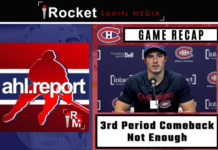by Christopher Nardella, Staff Writer, All Habs Hockey Magazine
POINTE CLAIRE, QC. — As hockey fans ardently await the commencement of another year’s World Junior Hockey Championship, here’s an introduction to Canada’s Gold Medal hopefuls on the back end.

Thomas Chabot (St. John Sea Dogs, drafted 18th overall by Ottawa in 2015)
After a meager rookie campaign in the QMJHL in 2013-14 that saw him develop habits that the coaching staff would no longer tolerate, the 6-foot-2-inch blue liner turned it around the next season. The Ste. Marie-de-Beauce, Quebec native shadowed fellow first rounder Jakub Zboril’s off ice habits and transformed his game in his own end to become a first round pick after not being ranked prior to the season. Chabot lead defenceman on the Sea Dogs with 41 points in 66 games in 2014-15, eight points higher than Zboril’s total.
Chabot has unparagoned speed for a player of his size, that asset being his greatest along with his excellent puck handling abilities. St. John general manager Darrell Young was complementary towards his defenceman’s development saying, “He’s more aware defensively, he’s playing tough in his own end but what’s impressing scouts is his skating ability, it’s elite level.”
Travis Dermott (Erie Otters, drafted 34th overall by Toronto in 2015)
Best described as unassailable, the Newmarket, Ontario native will likely play in the team’s bottom four, as his style is conducive to having success in that role. When the Leafs selected the 6-foot 197-pound defenceman in the second round of last year’s draft many were surprised that such would play out with his simplistic style. Dermott plays a very much unadorned style in that he makes the percentage play when he has the opportunity and he’s not a blueliner that will force a play.
His point totals have increased each season he’s spent in the OHL to the point where he had 27 points in 29 games before leaving for Canada’s camp. He’s an impregnable insertion into this Canadian lineup that has a considerably less ascendant roster than the one that took home gold on home soil last holiday season.
Haydn Fleury (Red Deer Rebels, drafted seventh overall by Carolina in 2014)
Much like Chabot, Fleury had appreciable bounds to make in his defensive game prior to being touted as a top ten pick in the 2014 draft. After a phenomenal sophmore campaign in his draft year the 6-foot-3-inch defenceman took a step back in his third season with only 28 point in 63 games. This year he had 20 points in 24 games before heading to Helsinki.
The Saskatchewanian is Canada’s most physical defenceman and, when amalgamated with his excellent speed and offensive ability, is the team’s foremost defender. “What really separates him from other guys that size is he’s got outstanding, elite-level skating ability,” said Bob McKenzie of TSN “Some scouts in [the 2014] draft believe Haydn Fleury has a better offensive upside and dynamic ability than Aaron Ekblad.”
Brandon Hickey (Boston University Terriers, drafted 64th overall by Calgary in 2014)
The only player out of college hockey to appear on Canada’s preliminary roster was originally drafted by the Tri-City Americans but chose BU. Antithetical to the majority of the Canadian blue line, Hickey had to develop his offensive game off the strong base he had in his own end. The Leduc, Alberta native had to develop the ability to know when to join the rush and supplement the Terriers’ attack.
As is paramount throughout the Canadian defensive core, Hickey has a strong skating ability and can chip in on the scoresheet. The only downside he has is the inability to recognize when he has to throw his weigh around. ESPN Boston’s Jeff Cox sees dependability in his game, “He plays well in his own zone and accepts the responsibility of being a defender first.”
Joe Hicketts (Victoria Royals, signed an entry-level contract with Detroit in 2014)
The lone returnee from 2015 on Canada’s blueline was utilized on the team’s top defensive pairing in pre-tournament action. Hicketts was deployed on Canada’s bottom four with the task of shutting down the opposing top lines, with partner Samuel Morin, which contributed to his trio of points in seven games. The 5-foot-8-inch defenceman had 30 points in 29 games prior to flying over to Finland.
The Victoriaville Royals captain is the team’s best passer, has one of the best shots and is a phenomenal skater which culminate to making him Canada’s most talented blueliner. “I give that offensive push from the backend […] I enjoy shutting down other teams’ top lines […] and with that I think I bring a physical presence,” said Hicketts of his game.
Roland McKeown (Kingston Frontenacs, drafted 50th overall by L.A. in 2014, traded to Carolina in Andrej Sekera deal)
After Noah Juulsen was cut, Roland McKeown stands as the lone right handed defenceman on the Canadian blueline. The former second round pick is versatile and plays a simple game in his own end, not unlike Brandon Hickey but does tend to overcommit in the offensive zone which leads to odd man rushes the other way. Not peerless to the rest of the roster, McKeown is a virtuous skater and is a solid facilitator however does so due to his mediocre shot. The Ontarian is best in his own end where, not only is he good at shutting down his opposition but also can enable the transition
His 28 points in 30 games prior to crossing the ocean were tops for the Frontenacs backend this season. Future Considerstions also gave a resplendent review of Kingston’s McKeown “McKeown is a strong, do-it-all defenceman who’s biggest asset is the ability to think the game and know his position.”
Travis Sanheim (Calgary Hitmen, drafted 17th overall by Philadelphia in 2014)
Considering the talent Canada has on their blueline it’s incredible to think that he’s the team’s best defenceman. The player who a has the highest points per game amount defenceman in the WHL is a dynamic skater especially relative to his 6-foot-3-inch frame that still has room to get bigger. Sanheim has great vision and a solid shot to complement the other phenomenal assets he has in his game.
Prior to the 2014 season, Bob McKenzie and Craig Button didn’t have Sanheim ranked but by seasons end Button had him at eighth. McKenize was very complementary of the ascendant blueliner, “He was dynamic [at the World Under-18 tournament] he’s a big man that can really skate and help move the puck out [of the defensive zone] and generate offence.” This player is extremely proficuous for Canada to have on their roster as he’s one of the best defenceman in the tournament.
~~~
With the egress of so many talented forward’s off of last year’s championship roster the blueline will be heavily depended upon to lead the gold medal underdog Canadians to glory once more.
Next up will be the diminished yet interesting Canadian forward core.
























